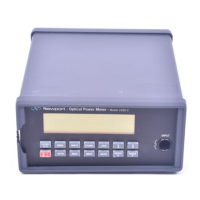24
5.4.3 General Guidelines for Using the RS-232C Port
• The RS-232C port can communicate with a dumb terminal or a personal
computer running any one of the many communications programs
available. You may also control your 1830-C using a personal computer
running high level programming languages such as Quick Basic or C and
lab automation software such as LabWindows and LabVIEW.
• When a dumb terminal type of device is used to communicate with the 1830-C
via the RS-232C, the echo mode is especially useful. When the “Echo Mode”
for the RS-232C port is enabled, all characters sent to the 1830-C and error
messages will be echoed. The 1830-C will generate a ‘>’ prompt for every
line. As the user enters commands, the line may be edited by using the
backspace key ( sending an ASCII decimal 08 code ) or by using the DEL
key ( sending an ASCII decimal 127 code ).
• When the 1830-C is being controlled by a high level programming lan-
guage, the echo mode should be disabled. When the “Echo” mode is
disabled, the 1830-C does not generate a prompt or echo characters back
to the interface.
NOTE:
The 1830-C’s default mode for RS-232C communication is with echo
disabled.
• Since the 1830-C’s output buffer size is limited to ten bytes, it is recom-
mended that when a query is made, the response to that query be read
before other commands are issued.
• Only one command/query may be sent to the 1830-C per bus transaction.
• 1830-C system errors can be identified by reading the 1830-C’s Status Byte
Register. (See Appendix A)
5.5 GPIB Communication
A variety of third party GPIB communication hardware and software, such
as plug-in GPIB computer boards and LabVIEW software from National
Instruments are available. The 1830-C should work with any of these as long
as they adhere to the IEEE 488.1 standard. This manual assumes the user is
familiar with one of these third party hardware/software packages. We refer
to GPIB and IEEE 488 interchangeably.
5.5.1 Setting the GPIB Address
The 1830-C GPIB interface port can be connected to the GPIB bus via a
standard IEEE 488 cable. Before communicating with the 1830-C GPIB port,
the 1830-C GPIB address must be set. Choose the appropriate 1830-C GPIB
address by setting the rear panel system switches to the desired address,
as shown in Figure 9.
NOTE
Cycle the power off and on or press the RESET button located at the back
of the meter whenever the GPIB address is changed.

